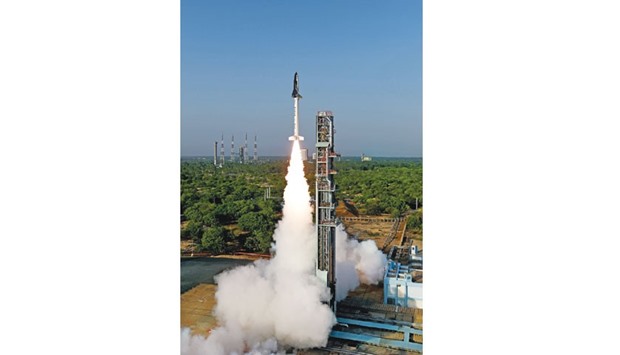
A u201cReusable Launch Vehicleu201d or RLV-TD is launched from Sriharikota on the southeast coast of India yesterday. The shuttle was developed on a budget of just Rs1bn, a fraction of the billions of dollars spent by other nations’ space programmes.
India successfully launched its first mini space shuttle yesterday as New Delhi’s famously frugal space agency joined the global race to make rockets as reusable as airplanes.
The shuttle was reportedly developed on a budget of just Rs1bn($14mn), a fraction of the billions of dollars spent by other nations’ space programmes.
The Reusable Launch Vehicle, or RLV-TD, which is around the size of a minibus, hurtled into a blue sky over southeast India after its 7am lift-off.
After reaching an altitude of about 70km, it glided back down to Earth, splashing into the Bay of Bengal 10 minutes later.
The test mission was a small but crucial step towards eventually developing a full-size, reusable version of the shuttle to make space travel easier and cheaper in the future.
“We have successfully accomplished the RLV mission as a technology demonstrator,” Indian Space Research Organisation (ISRO) spokesman Devi Prasad Karnik said.
The worldwide race for reuseable rockets intensified after Nasa retired its space shuttle programme in 2011.
They are seen as key to cutting costs and waste in the space industry, which currently loses millions of dollars in jettisoned machinery after each launch.
Internet tycoon Elon Musk’s SpaceX and Blue Origin of Amazon owner Jeff Bezos have already successfully carried out their own test launches.
Musk told reporters in April that it currently costs about $300,000 to fuel a rocket and about $60mn to build one.
SpaceX first landed its powerful Falcon 9 rocket in December while Blue Origin’s New Shepard successfully completed a third launch and vertical landing in April this year.
But ISRO hopes to develop its own version, primarily to cash in on the huge and lucrative demand from other countries to send up their satellites.
The Indian space agency is no stranger to stellar achievements on a shoestring budget.
It made global headlines in 2013 after sending an unmanned rocket to orbit Mars at a cost of just $73mn.
Nasa’s Maven Mars mission had a $671mn price tag.
The launch and its low cost were a source of immense pride in India, which beat China in becoming the first Asian country to reach the Red Planet.
K Sivan, a scientist involved in the latest project, said the 7m-long shuttle survived the test flight, and scientists hope subsequent models six times as big, to be built over the next decade, will glide safely back to land.
“We have located the place where the vehicle is floating. The landing was soft and the vehicle did not break,” Sivan said.
“The mission went off as planned and data from the experiment showed that we have achieved its objectives and demonstrated the RLV technology.”
“The long-term objective of this mission is to reduce the launch cost by 80% of the present cost by using a reusable vehicle,” Sivan said ahead of the test.
Rockets and support systems for launching satellites and space exploration missions are made at the space agency’s Vikram Sarabhai Space Centre at Thiruvananthapuram in Kerala.
However, the future of India’s RLV depends on factors like its economic viability compared to conventional expendable rockets; development of a powerful engine/stage to power that vehicle and also availability of funding for the project.
Meanwhile, ISRO will soon be testing its air breathing engine.
Air-breathing engines use atmospheric oxygen and burn it with the stored on-board fuel to generate the onward thrust.
Conventional rockets carry both oxygen and chemical fuel on board.
“We will soon be testing - may be this June - our air breathing engine fitted to a sounding rocket,” Sivan said.
Prime Minister Narendra Modi praised the “industrious efforts” of ISRO scientists.
“Dynamism & dedication with which our scientists & @isro have worked over the years is exceptional and very inspiring,” Modi said on Twitter.
Modi has often hailed India’s budget space technology, quipping in 2014 that a local rocket that launched four foreign satellites into orbit had cost less to make than Hollywood film Gravity.


